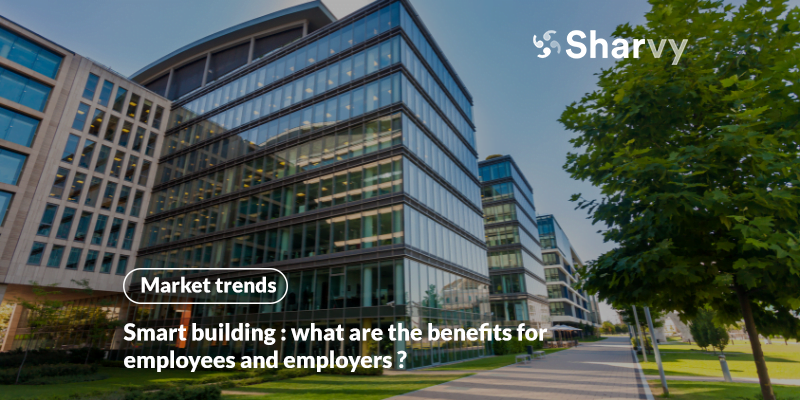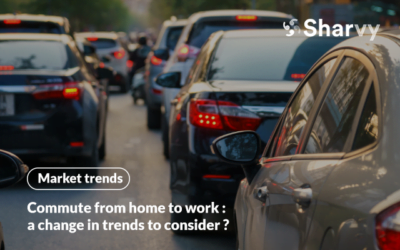At the cutting edge of innovation, smart buildings are about to make a lasting difference in the daily lives of thousands of businesses.
Suppose it comes close to the futuristic visions thought up and imagined by the directors of the twentieth century’s greatest thrillers. In that case, the smart building holds a multitude of technological solutions with differentiating and competitive advantages for businesses.
So they can’t turn a deaf ear! But apart from its advantages, what is a “smart building” really? What are the benefits of opting for a smart building? And what are the challenges facing companies? Find out in this article.
A quick reminder : what is a smart building?
To fully understand smart buildings, we need to go back to its basis, the smart grid.
This intelligent electrical network connects the different electrical systems in the same space to create a global interconnection. With this installation, technologies, however different, can communicate and work together.
As a result, smart grids are paving the way for smart buildings. Smart buildings incorporate a range of technologies, such as AI (Artificial Intelligence), IoT (Internet of Things), BMS (Building Management System), biometrics, building automation, and many others, revolutionizing the working environment of yesteryear.
The aim is to optimize the comfort, well-being, and safety of occupants while improving the building’s energy efficiency.
Smart building : what are the benefits for employees?
1. A healthier working environment.
There’s no doubt about it : the Covid-19 health crisis has highlighted the importance of Indoor Air Quality (IAQ) in buildings. This is something that needs to be addressed for too long, even though we spend more than 80% of our time in enclosed spaces (at work, at school, at home).
There is no such thing as pure air, but various studies have shown that pollution is much more prevalent inside a building than outside. This is for a variety of reasons : chemical pollutants (organic volatiles, endocrine disruptors), biological pollutants (allergens from dust mites, plants, and mold caused by dampness), particles and fibers (dust, tobacco smoke, fuel heating), as well as physical pollutants (radon, for example, which is found in many enclosed environments and is unfortunately one of the leading causes of lung cancer).
Although awareness of the importance of IAQ is recent in the UK, the good news is that it is booming. The reason is that mediocre IAQ is never neutral for employees : it can lead to “sick building” syndrome. In other words, itchy eyes, headaches, difficulty concentrating, increased fatigue, and so on. All of which, of course, has a detrimental effect on productivity within the company.
That’s one of the reasons why intelligent sensors are such an integral part of smart buildings! Thanks to these sensors, employees can enjoy a healthier working environment.
For example, with the advanced technologies offered by smart buildings, we can combat various allergies (pollen, dust, allergens, etc.) via IoT sensors that trigger air purification. It’s not a bad thing for asthmatics and allergy sufferers. In the same vein, Water Quality (WQ) sensors can also warn employees of any unusual accumulation of pollutants.
2. An asset for improving comfort and well-being in the workplace.
The intelligence of the smart building is based on its ability to predict and interact with its environment. It combines data from various sources and incorporates an automation system to optimize energy consumption, maximize building performance, and enhance occupant comfort.
However, the real strength of the smart building lies in its ability to offer multiple services to improve employees’ day-to-day lives and well-being. From parking assistance and shopping delivery to workspace reservation, the smart building is designed to be multi-serviced.
A typical day in a smart building might look like this :
- As soon as employees arrive at the car park, the experience is digital. A camera reads the number plate of the vehicle in front of the car park barrier and authorizes access to the car park if a reservation has been made. A space is allocated dynamically, so there’s no need to turn around to look for one. Sharvy, for example, is one of the pioneers of this type of SaaS solution, which integrates perfectly with smart buildings.
- To gain access to the building, you no longer need the traditional badge that your employees can lose and swap between themselves. A paperless version is much more reliable and allows you to manage access – entry and exit – in fine detail and to classify company areas to which outsiders do not have access rights. This type of access control can also be deactivated remotely once the employee’s work period is over, for example, for temporary and fixed-term contracts.
- As part of the flex office approach, smart buildings are integrating desk booking applications such as Sharvy to ensure that early risers are not spoilt for choice and that places become scarce after 9am. This allows you to move away from the traditional flex office system, which is based on the “first come, first served” principle. Your employees can reserve a seat in advance of their arrival.
- A meeting during the day? In a smart building, the room itself regulates its equipment to achieve the comfort level defined by the employee (lighting intensity, room temperature, ventilation for IAQ). They can change these settings at any time via a dedicated application to adapt them to a new comfort level.
- Want to have lunch without wasting time? In a smart building, employees can book a lunch slot remotely. No more queues or long waits outside the cafeteria!
This typical day clearly shows that smart building services meet the challenge of improving QWL (Quality of Life and Working Conditions) at several levels (comfort, hygiene, safety).
3. A more inclusive workspace that responds to societal challenges.
This is another advantage of smart buildings that should be noticed. In essence, thanks to the omnipresence of technologies that make occupants daily lives easier, smart buildings make it possible to respond to the increasingly important issues of inclusion, equality, and fairness in the workplace.
As a brief reminder, a genuinely inclusive office is a place where everyone feels respected, accepted, and supported, whatever their characteristics, such as origin, skin color, gender, sexual orientation, disability, or socio-cultural background.
Every employee must, therefore, benefit from the same quality of facilities and services.
For example, technological innovations based on artificial intelligence, robotics, and building automation are improving the daily lives of people with reduced mobility. A simple press of a button, a gesture, or a word is all it takes to control a range of equipment in the workspace (intelligent lighting, temperature management, opening and closing doors, etc.). These technologies offer greater autonomy and independence for people with disabilities.
Similarly, smart buildings can incorporate a range of assistive technologies.
For example, a screen reader that identifies what is displayed on an employee’s screen and reads it to them. This function is beneficial not only for employees with visual impairments but also for those for whom bright screens cause migraines and other problems.
At the same time, there is also voice recognition technology to help employees who find it difficult to type on a keyboard all day. Instead, they can tell their device what to type using their voice.
4. A workspace that improves employee efficiency and productivity.
There’s no doubt about it : the technologies integrated into smart buildings offer a host of digital tools that simplify employees’ daily lives and automate low-added-value tasks, significantly boosting their productivity.
In the same way, the smart building opens the doors to the smart office, which offers employees an ecosystem of platforms, IoT, services, and various software applications thatsignificantly improve their performance and, in correlation, the company’s results! The IoT, for example, can reduce the drudgery of particular professions and streamline business processes.
5. The smart building anticipates deficiencies to ensure optimum use of the building.
During the day, the building was pleasant to use for all employees, partly because other services went well without them even realizing it.
Equipped with sensors, the installations in a smart building (lifts, goods lifts, machinery, etc.) are linked to an artificial intelligence system that uses machine learning to anticipate the risks of malfunction.
The extensive information on the health of systems is communicated in real-time. This is why an alert is sent if an unusual malfunction is identified.
A technician can then be dispatched to the site even before the problem appears and carry out preventive maintenance. By proceeding in this way, breakdowns tend to be avoided! For example, if the lift was about to break down, an alarm would be triggered, and the technician would be dispatched to the site to repair it. This is excellent news for all employees, particularly for people with reduced mobility (PRMs), who were spared any inconvenience during the day.
Depending on the nature of the problem, faults can even be resolved remotely without having to wait for a caretaker or staff member to spot the flaw and contact a technician.
Smart building : what are the benefits for companies?
1. Anticipation of occupancy and usage trends.
In recent years, new paradigms in the world of work (flex office, hot desking, corpoworking) and the implementation of hybrid working have led to several organizational challenges. In response to these challenges, solutions are emerging in the form of smart buildings.
Thanks to the many technologies installed in every corner of the building and various sensors, the smart building can measure the actual occupancy rate of workspaces (meeting rooms, open spaces, callboxes, etc). The data collected is then stored in a SaaS solution like Sharvy.
It should be noted that contrary to popular belief, the data generated by the sensors is entirely anonymous and is only used to optimize workspaces, from a property point of view, to manage and develop the workplace.
Using the SaaS solution, the sensors provide employers and employees alike with valuable information.
- For employees : with a flex office, they can manage and reserve the workspaces (and equipment) they need during the week (a dual-screen workstation, a meeting box, a huddle room, etc). In this way, frustrations are eliminated, as are existential questions such as : “Will there be a workstation available when I arrive ?“.
- For employers : it’s clear that certain days will be busier in terms of occupancy. However, thanks to the data collected by the sensors, coupled with a SaaS solution for reserving spaces, they can anticipate peaks in occupancy.
Ultimately, the smart building will enable employers to make the right management decisions, providing a reliable basis for adjusting the desk-sharing ratio at which workspaces are crowded. At the same time, cleaning and maintenance teams will be able to know in real-time which spaces need to be cleaned and which tasks need to be carried out.
2. Improving the daily life of facility managers.
In the same way as home automation on the scale of a house, building automation applies on a larger scale. It is suitable for all categories of buildings: tertiary, residential, and service (hospitals, factories, schools, etc).
Building automation promotes interconnection and interaction between a building’s various technical installations. Using a range of sensors – for movement, light, heat, etc. – actuators, programs, and software, facility managers can quickly improve their day-to-day work.
Thanks to these technologies, they can create various scenarios. For example, they can imagine an “End of working day” scenario that starts at 7 p.m. After this time, access to the building is locked, and all the lights and heating are switched off. Finally, the surveillance cameras and motion detectors are activated.
3. The smart building offers a (non-negligible) gain in security.
Smart buildings can improve the building’s security systems through centralized and 100% autonomous management of its remote surveillance systems and alarms.
For example, they can spot an abnormal temperature rise even before smoke is detected, detect and trace a water leak, check that doors and windows are locked, and so on. All indicators anticipate and prevent tragedies.
At the same time, and thanks to “new generation” automated access management, the smart building makes it possible to efficiently control and manage the flow of people in and out of the building. This makes it possible to protect the building and the employees in it by authorizing access only to trusted people, from the car park to the doors of the building.
4. A solution to prevent energy waste in buildings.
With the ecological crisis as a backdrop, the UK has made reducing energy consumption one of its priorities. The smart building is one of the solutions ideally suited to the task, thanks to ingenious energy management within the building.
The reason is that in a smart building, the management of lighting, air conditioning, ventilation, and heating is optimized to reduce energy wastage.
At the same time, all the data collected by various sensors enables employers and landlords to understand the building’s consumption, energy-hungry areas, and areas of heat loss. This smart building mapping allows the equipment to be adjusted and good practices to be adopted. And thanks to the ubiquity of technologies and sensors, this vigilance over energy consumption is not a one-off event but a permanent feature!
As a result, the energy requirements of the whole building are adapted to the real needs of the employees rather than to the necessities they claim to have, which is quite different! This means that costs can be drastically reduced.
One example is a system for regulating the temperature of a building according to its occupancy rate. During the summer months, many employees are on holiday. As a result, many rooms and open spaces may need to be emptied. These spaces will need less air conditioning than a whole room, where the number of employees present heats the area.
5. Smart building improves employer brand.
Smart buildings are part of a global approach to preserving the environment, in line with CSR objectives. A company that chooses a smart building as its new office first and foremost conveys a positive image of a company that cares about the environment.
At the same time, the company’s headquarters will be directly more attractive to future employees. In addition to the increased interest in new technologies in the workplace, candidates are increasingly interested in working for a company that is close to its values in line with its commitments and ethics.
What’s more, moving into a smart building also allows you to obtain labels and certifications that prove your company’s commitment to the environment and enhance your employer brand. From Haute Qualité Environnementale (HQE) to Building Research Establishment Environmental Assessment Method (BREEAM), there are many international labels recognizing a company’s efforts to protect the environment and its employees.
What are the (potential) risks of smart buildings?
Despite its many advantages, smart building has its drawbacks.
Firstly, the building is (even) more vulnerable to computer attacks. For example, in 2018, a cyberattack targeting a video surveillance and thermal management system in a tertiary building led to major disruptions, compromising the security of the premises and increasing the energy bill. To limit this vulnerability, a constant and reliable Internet connection is required at all times.
At the same time, ensuring that employees’ private data is handled responsibly and in compliance with data protection regulations is essential. This means being transparent about how data is collected, used, and shared. Respecting employee consent is, therefore, an essential prerequisite.
Ultimately, while smart buildings help to reduce building operating costs over the long term, it is also important to realize that installing the various technologies represents a fairly substantial initial investment. This is particularly true for tiny businesses. And while the costs depend mainly on the size of the building and the number of solutions installed, it’s essential to bear this in mind.
In conclusion
There’s no doubt about it : transforming a building into a smart building is a pragmatic response to the new paradigms of the world of work and, above all, to the new aspirations of millions of men and women whom the economic argument can no longer convince.
Faced with the rise of unhappiness in the workplace and the difficulty of attracting young talent, it is becoming a harmonious mediator for QWL and the sustainability of companies!
A question? Check the following FAQ!
Why is the smart building increasingly attractive to employers?
Tertiary and residential buildings alone account for more than half of all energy consumption in the UK. Given its financial and environmental advantages, the smart building is an excellent alternative to conventional buildings.
It provides better control and management of energy consumption and any losses. At the same time, it provides employees with better working conditions and an improved, optimized view of their workspaces.
Do smart buildings present a risk of overexposure to electromagnetic waves?
Although no studies have yet concluded that electromagnetic waves in smart buildings are dangerous, the subject is still being debated in the scientific world! Not least because of the emergence of electrohypersensitivity disorders (EHS) in some people in recent years.
That’s why, to limit electromagnetic wave fields in offices, since 1 January 2017, a decree has required every employer to carry out a risk assessment in their building. They must then draw up a single risk assessment document (DUER).
In the event of doubtful results, no penalty will be applied, but advice will be given, and a medical examination will be prescribed!
Want to learn more? Check out our latest articles!
How can your inter-company restaurant adapt to teleworking?
Teleworking : how can you manage the number of people using your inter-company restaurant & adapt your offer to new working habits? Focus.
Change management : how to facilitate the adoption of a new tool?
What are the essential steps to facilitate change management in your company ? Our advice and best practices can be found here.
Commute from home to work : a change in trends to consider ?
Commute from home to work : what trends can be observed? What are the risks? How can they be improved? Focus in this article.
Subscribe to our newsletter!
PARKING & WORKPLACE MANAGEMENT SOLUTION
Car park management - Charging points monitoring - Desk booking - Booking by time slots
SUBSCRIBE TO THE NEWSLETTER
Receive the latest Parking & Workplace trends by email once a month.













